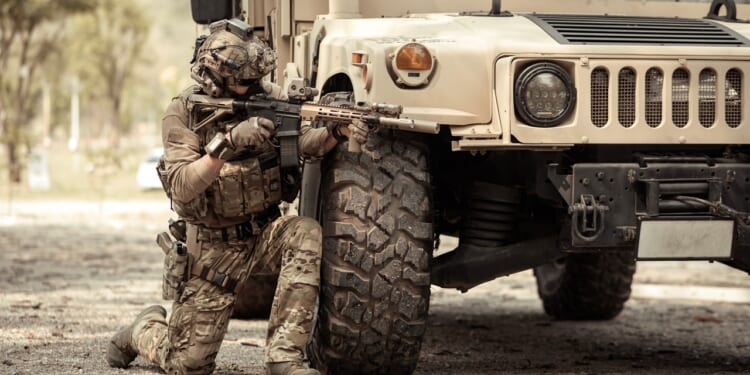The Gladius system was first introduced nearly 20 years ago as part of the “Infantry Soldier of the Future” package, offering network capability to the individual warfighter.
The nomenclature of modern weapons systems is something that can only be described as a bit confusing. Although it may be meant to honor the past—as in the BGM-109 Tomahawk cruise missile, meant to honor the warfighting spirit of the Native Americans—there are cases where it seems counterintuitive.
A “claymore” was the name given to the Scottish basket-hilt broadsword, likely from the Gaelic “claidheamh mor,” meaning “great sword.” Centuries later, American arms inventor Norman MacLeod opted to name his “anti-personnel fragmentation weapon” in honor of the famed sword of his Scottish ancestors, leading to the M18A1 Claymore mine—though the weapon has little in common with a sword.
Today, one might reasonably ask why German arms maker Rheinmetall opted to name its Gladius advanced armor system after the “gladius” sword carried by the Roman foot soldiers for nearly 600 years. A gladius, after all, was a sword, not a suit of armor. Just as importantly, someone at Rheinmetall might have observed during the naming process that Rome fought against the Germanic tribes for centuries!
Semantics aside, the Gladius 2.0 was recently showcased at the Defence and Security Equipment International (DSEI) 2025 exhibition in London, to positive reviews.
The Gladius System Gives Soldiers Modern Battle Armor
The Gladius system was first introduced nearly 20 years ago, as part of the Infanterist der Zukunft (IdZ) or “Infantry Soldier of the Future,” offering network capability to the individual warfighter. The system has steadily evolved, providing each dismounted soldier with an Android-powered smartphone as the primary “end-user device” (EUD), a change from the previous solutions that included a tablet PC.
For the IdZ, every ounce of equipment matters, and it was determined that a ruggedized phone would still host Rheinmetall’s TacNet Battle Management Suite, which provides situational awareness, including the location of friendly forces. Information can be transmitted to the individual soldier’s head-mounted display, thus minimizing the need for a large tablet device.
At the recent DSEI arms show, Rheinmetall showcased the Thea heads-up display. Developed by Greek-based Theon, Thea is being integrated into the Gladius 2.0 IdZ system, where it can provide real-time information received by the TacNet display from the EUD. It is augmented reality-enabled, which means it could be used in training exercises where each soldier would “see” notional enemy soldiers or vehicles.
Thea can be integrated with existing Gladius helmets, connected either wirelessly or via a wired connection, while the EUD utilizes 5G network connectivity.
The Gladius Armor Has Multiple Variations
The Gladius 2.0 system is being developed in various configurations, including a lightweight model, flexible model, and multi-role model, with different options depending on mission needs. In addition to providing greater situational awareness to the modern infantryman, the system utilizes “smart textiles” that enable real-time biomonitoring of individual soldiers.
“In the event of critical vital data, an automated rescue chain can be triggered without delay,” Rheinmetall explained.
Last year, Rheinmetall also entered into a partnership with biometrics startup QUS Body Connected, which has developed solutions that can track vital data, including heart and respiratory rates.
“Biomonitoring, as we know it from competitive sports, will also play an important role for soldiers in the future to optimize operational readiness. For us as a system provider, QUS’s solution offers an additional component in our modular soldier system. And with a view to digitization, AI-supported data can make an important contribution to tactical decisions at higher command levels,” said Timo Haas, chief digital officer (CDO) at Rheinmetall AG.
The Gladius system is one of several modern battle armor solutions now in development. The UK has been developing its Virtus integrated body armor with a tactical digital network, and China has initiated a comprehensive “Integrated Soldier Combat System” as part of an effort to create a fully networked fighting force.
Russia has introduced its own “Soldier of the Future” program, dubbed “Ratnik” (Russian for “warrior”). It is also equipped with a wireless, networked communication system to provide enhanced situational awareness and information sharing among soldiers. However, while highly touted by the Kremlin, the armor has seen only limited use in the ongoing conflict in Ukraine, likely due to issues of cost and connectivity.
There remains concern in multiple nations that even with encryption, any battle network could be hacked or disrupted, leaving the soldiers of the future with added equipment that does not deliver as advertised.
However, the unanswered question remains why Germany’s platform is named after the Roman sword, when there were better options, including “Lamellar,” the armor worn by the Goths and Vandals, or “Maximilian,” the 16th-century armor named after the Holy Roman Emperor Maximilian I. Even “Rüstung,” the German word for medieval armor, would have made more sense!
About the Author: Peter Suciu
Peter Suciu has contributed over 3,200 published pieces to more than four dozen magazines and websites over a 30-year career in journalism. He regularly writes about military hardware, firearms history, cybersecurity, politics, and international affairs. Peter is also a contributing writer for Forbes and Clearance Jobs. He is based in Michigan. You can follow him on Twitter: @PeterSuciu. You can email the author: [email protected].
Image: Shutterstock / Thanakorn.P.

















